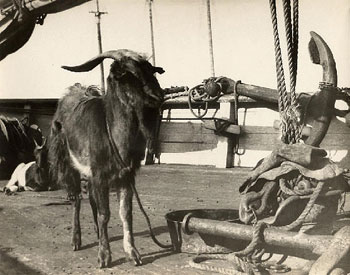Livestock on Board
Livestock in the form of pigs, chickens, ducks, sheep, goats, and sometimes even cows could be found in specially constructed crates or pens on deck. And some skippers let the animals roam freely, occasionally even into the cabins below. At various ports along the way, if livestock was available and there was space, more animals were added to the ship's menagerie.
Chickens would provide eggs, goats and cows gave milk, but the other animals would eventually become meals themselves. Mary Colson on board the George and Susan in 1878 wrote: "I do hope we shall never have another animal on board this ship for I get fond of them and they of me and then they either die or are killed."
New England whalers' first stop was often across the Atlantic in the Azores or Cape Verde Islands. By the time ships got there, fresh food had begun to run out. Fortunately, the climate was warm and temperate, providing fresh fruit, vegetables, and water, as well as livestock.

New Bedford Whaling Museum